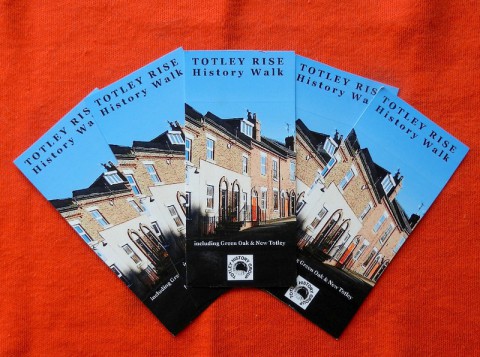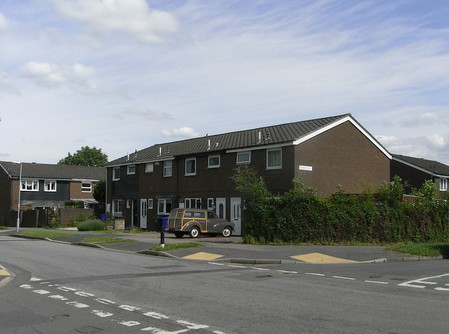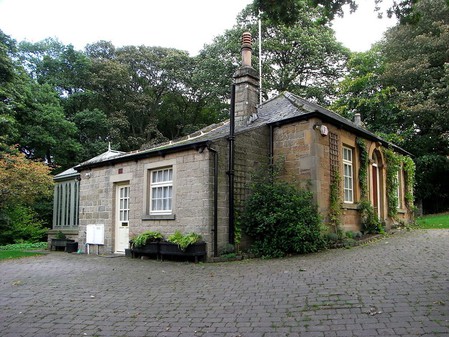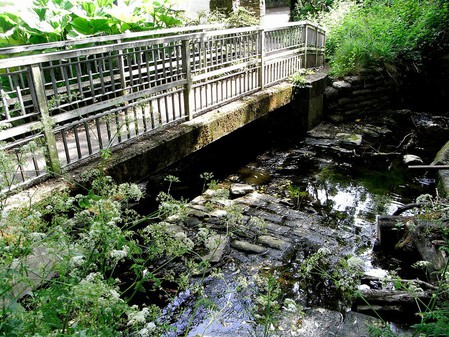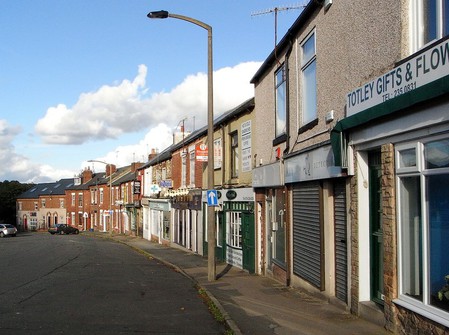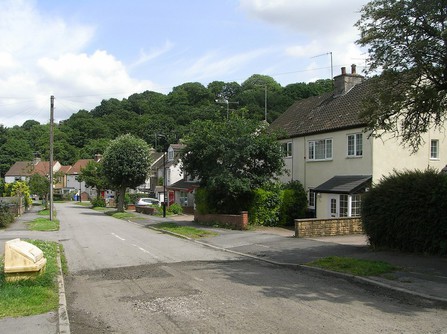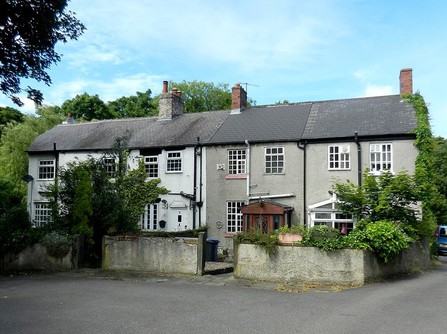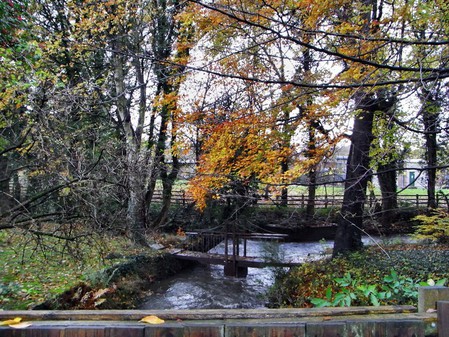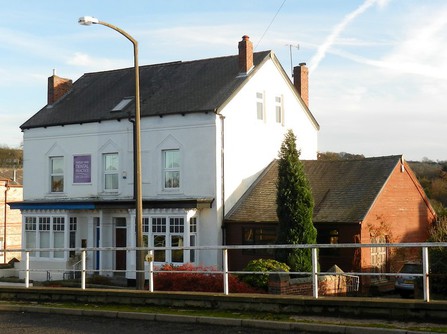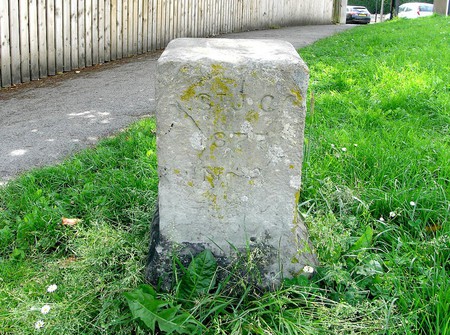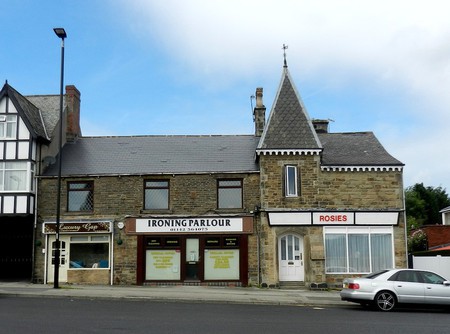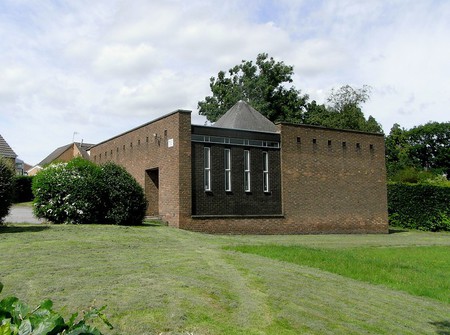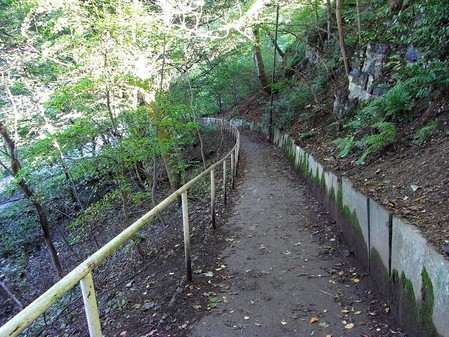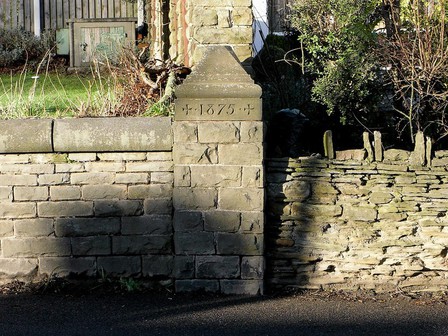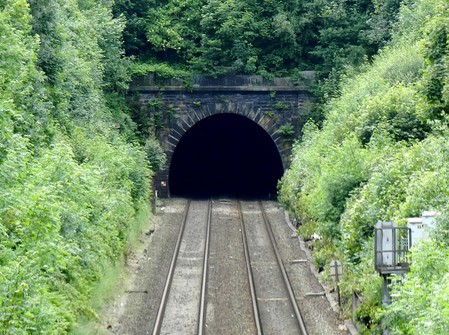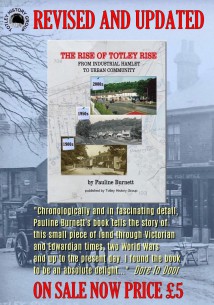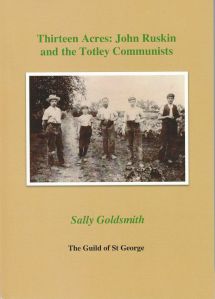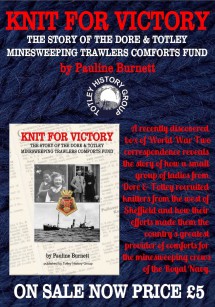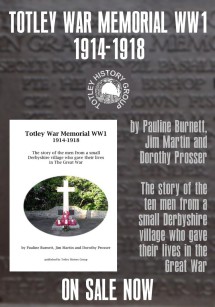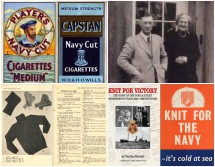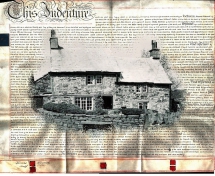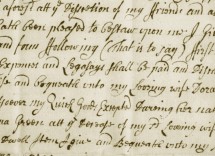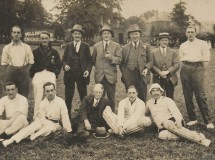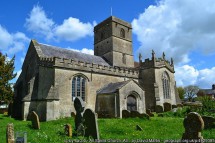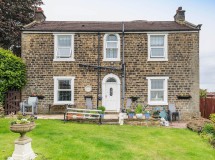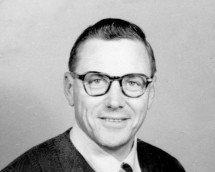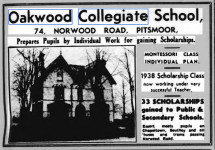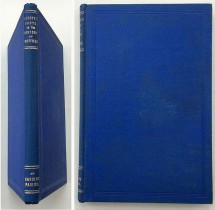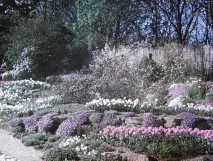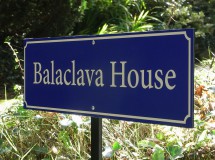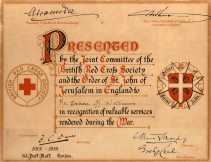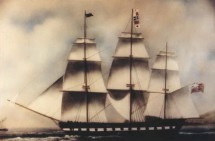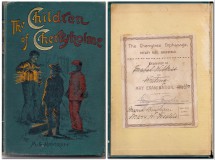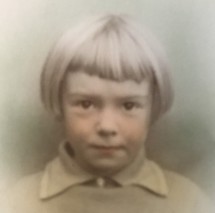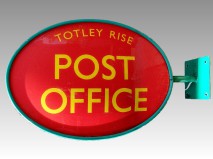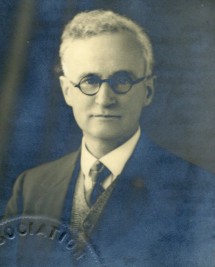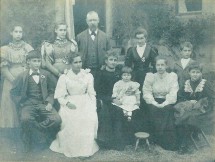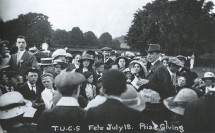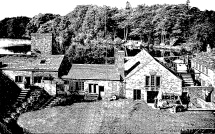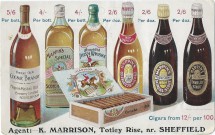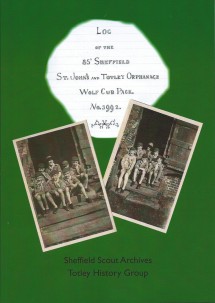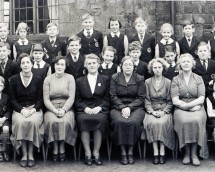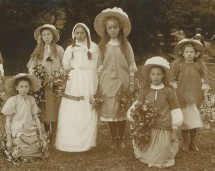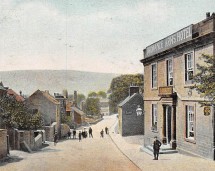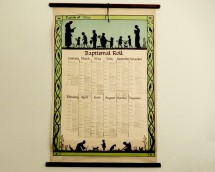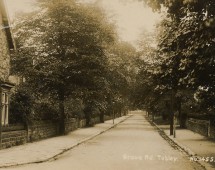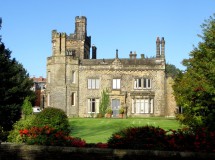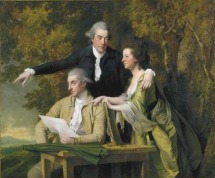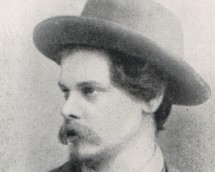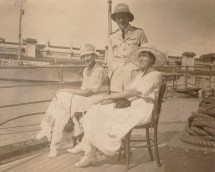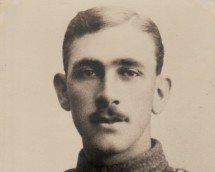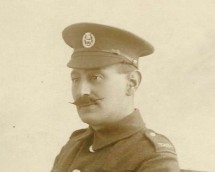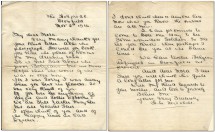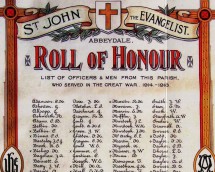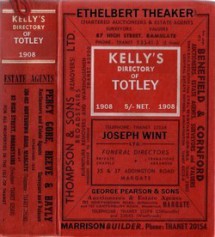Totley Rise History Walk
This is a walk around the parts of Totley we left out of our leaflet. It is to be developed, tested, measured. The walk starts from and ends at the Library
A version of the walk is available in PDF format for home printing.
TR-walk-5-August-2014.pdf
Adobe Acrobat document [1.3 MB]
Comments, corrections and suggestions are most welcome to:
This is a walk around New Totley, Green Oak and that part of Totley Rise that lies within the traditional boundaries of Totley township. The walk starts and ends at Totley Library, 205 Baslow Road, S17 4DT, about 6 miles southwest of Sheffield on the A621 and a stopping point on bus route 97 from the city centre. Click here for the current timetable.
1. Totley Library Baslow Road, south side
Totley Library moved here in 1964 from the building next to Tesco Express, Baslow Road (in Dore) which had been converted from an electricity showroom and offices in 1939. The new library was built on land that had been owned by George Pearson & Sons, nurserymen and market gardeners, who constructed two large glasshouses for their business which became known as Heatherfield Nurseries.
Follow the footpath away from Baslow Road down to Lemont Road, turn left and cross the road. After passing Mona Villas, enter the park.
2. Green Oak Recreation Ground off Lemont Road, south side
The Recreation Ground was opened by Mrs Sarah Milner, of Totley Hall, on 23 March 1929 on two pieces of land sold to Norton Rural District Council by John Thomas Carr, a retired farmer and butcher, for the sum of £1,550. The sale also included a small plot of land and buildings on the south side of Lemont Road for access. To the west was Pearsons' nursery and to the south and east Colin Thompson's farm land. The bowling green was constructed in 1956 and opened the following year.
Leave by the small gate at the opposite end of the park, beyond the children's playground. Bear right through the cul-de-sac on to Green Oak Avenue. Turn left and walk a short distance down to the cross roads of Green Oak Road and Aldam Way.
3. The Last Prefabs (site of) Green Oak Road, south side
Prefabs (prefabricated bungalows) were a quick-fix remedy for housing shortages between and after the two World Wars. The Totley prefabs were probably of an American design and, as these structures went, were of a high standard, particularly the fittings, bathrooms and floors. Built mainly during 1945, they were neatly laid out on paths and covered much of the area that is now the upper part of Green Oak Road, Green Oak Avenue and Aldam Way. They were never intended to last as long as they did - the last prefabs being demolished in the early 1970s.
Turn left down Green Oak Road and second right into Aldam Road. Cross the road and after a short distance turn left at the public footpath sign. Ignoring the main path to your right which leads towards Gillfield Wood, carry on past the Scout Hut, across a small wooden footbridge over the Totley Brook and up a short but steep bank on to the lane. Turn right and walk a short distance to the next farm gate on your left at the top of the rise.
4. Woodthorpe Hall Drive & St. George's Farm off Mickley Lane, west side
The lane up to Woodthorpe Hall has been known by various names including White(s) Drive or Lane. There is a view across the field to the rear of the farm which is just over the Totley boundary into Dronfield (see inset). The 13 acre farm was referred to by a variety of names before it was bought by the Guild of St George in 1877. The Guild had been established in 1871 by the artist, writer and social thinker John Ruskin who had a Utopian vision of creating a place of beauty and peace, working the land as a model orchard and botanical garden without modern machinery whilst encouraging traditional crafts. The land was first used as allotments and later as a land colony but by 1880 the venture had foundered. The farm was taken over at first by Ruskin's own head gardener whose attempts to grow strawberries, currents and gooseberries also failed. In 1889 George Pearson took over the farm at first as a tenant. In the 1920s, when the Guild was divesting itself of its smaller holdings, Pearson was offered and bought the farm outright. The family business has flourished ever since.
Retrace your steps along the lane and turn right over the stile before the allotments and up the path to the exit via the car park at the top of the field.
5. Mickley Hall Mickley Lane, east side
Mickley Hall, as it is now called, was purpose-built in 1867-68 for the Cherrytree Orphanage which had been founded in Sheffield by the Rev. Edward Ridge Taylor, a former army chaplain, three years before Dr. Barnado formed his home in London. So great was the demand for places that the Orphanage moved to larger premises firstly in Highfield and then in Totley. In April 1868, the property was transferred to a board of 22 trustees which included George Bassett and Thomas Cole (Cole Brothers) as an institution to receive poor children whose parents had died in order to receive board, clothing, education and religious instruction. Children were given the chance to learn a trade and introduced to new homes.
Approval was given by the trustees in October 1964 to sell the Cherrytree buildings to the Cheshire Foundation, a disability charity named after Group Captain Leonard Cheshire, for £12,000 plus £500 towards the cost of roads, if needed. In 1967 the Sheffield Cheshire Home was formally opened by Her Grace, the Duchess of Devonshire in the building vacated by Cherrytree Childrens Homes. It is Grade II listed.
Descend Mickley Lane on the footpath, taking care as there are some blind corners.
6. Brook Hall Mickley Lane, east side
Brook Hall was built in the early 19th century for Joseph Ward, coal merchant, and bought by Cherrytree Orphanage in 1867 for use on a temporary basis until the larger building on adjacent land could be built. It is now a Grade II listed building. The Coach House and Stable to the rear were built in the same period and are separately listed Grade II.
7. Brook Hall Lodge Mickley Lane, east side
Cherry Tree Lodge as it is now called was built circa 1850 as the lodge to Brook Hall. It is also Grade II listed.
8. Totley Lane Mickley Lane, east side
This old trackway climbs steeply uphill towards Hall Farm and Tinker's Corner in Lower Bradway. Only the very bottom section, below the original course of the Lumb Brook, is in Totley. The brook has been diverted from joining the Totley Brook at the bottom of Queen Victoria Road via a culvert under Mickley Lane.
9. Shepley Spitfire Mickley Lane, west side
The pub was built in 1979 by Hardys & Hansons Brewery of Nottingham. It is named after Pilot Officer Douglas Shepley of Woodthorpe Hall who died in 1940 when his plane was shot down and whose family raised funds to buy a new aircraft. Whilst the Spitfire weather vane remains, the splendid pub sign which incorporated a photo of Douglas has recently been mounted on the wall near the steps up to the entrance.
10. Brook Terrace (site of) Mickley Lane, east side
Brook Terrace (numbers 79-85 Mickley Lane) was built around 1888 on the other side of the road, between Glover Road and the Totley Brook. Harry Brearley (1871-1948), the inventor of stainless steel, moved into the end house nearest Glover Road in 1895. He was still living there at the time of the census six years later but by 1910 he had moved to Old Whittington, Chesterfield. The terrace was demolished around 1956.
Turn right into Laverdene Avenue.
11. Old Ford & The Chemical Yard (site of) off Laverdene Avenue, east side
Back Lane used to run from Bricky Row across a ford over Totley Brook to an upper section leading up to Queen Victoria Road. The footbridge is close to where the old ford was and the cobbles can still be seen when water levels are low. On the Bradway side was the Chemical Yard where Tinker & Siddall first manufactured chemicals in the 1840s. By 1857 Tinker & Co had extensive chemical works there and by 1889 Thomas Kilner was manufacturing pyroliginous acid, naptha and charcoal. The area was later used for various purposes including a blacksmiths, the Brookvale Laundry and C J Marcroft's builders yard.
Continue along Laverdene Avenue which bends to the right, cross to the left of the road and then follow the footpath to the left of the high wall. Turn left at Glen Rose, up the hill to the corner of Back Lane and Glover Road. Walk down the lay-by in front of the shops.
12. Bricky Row Baslow Road, southeast side
Very little has been written about the early years of the Totley Rise shopping crescent (15-71 Baslow Road) beyond that it was originally a row of houses built circa 1888 to provide accommodation for the navvies who built the Totley Tunnel. New research suggests, however, that the houses may not have been built all at the same time and that most of the row was in existence before 1881. Whilst a few shops date from around 1888, such as Colin Thompson's butchers, the conversion of the upper part of the terrace to shops and businesses came later. The top section of the row was owned by a brewery and it was intended to build a hotel on the corner by Back Lane. When an application for a drinks licence was declined, the property was subdivided and converted into shops. More research is needed.
13. Rolling Mill Pond (site of) Mill Dale Road
The Rolling Mill pond was at the back of Bricky Row, where the extension to Laverdene Avenue is now, widening out at the bottom of the Rise and taking in most of what is now Mill Dale Road. The mill was fed by the Totley Brook but, in addition, there was a massive stone weir near the present Methodist Church which diverted the Oldhay Brook into the pond when necessary. The weir was dismantled in 1933, the dam wall having been removed in 1920. It is said that the stone was taken to Millhouses and re-used to build a tea-room extension to the Waggon & Horses.
Continue down Baslow Road and turn right at path in front of the small triangular green into Mill Lane.
14. Rolling Mill Cottages Mill Lane, west side
There was a complex of buildings at the northern end of the mill pond including these terraced cottages which were built for the mill workers and the cottage on the other side of Mill Lane which was the mill manager's house. It is not known when the first mill was built but in 1615 the Gill family had a lead smelting mill here. By 1750 part of the mill was converted to a grinding wheel and by 1780 a lead rolling mill was in operation. In 1836 John Dyson bought the mill for steel-rolling. He had a grinding wheel, 4 troughs, smelting furnace, brickyard, kiln and blacksmiths shop here as well as gardens, a wood and the dam. By 1872 William Tyzack & Sons were operating as steel rollers and they also made scythes and sickles here. Ebenezer Hall, of Abbeydale Hall, bought the mill in 1881 and production ceased a few years later.
Continue to the end of Mill Lane and on to a very narrow footpath between the high garden fences of Poynton Water on your left and Mill Cottage on your right towards a small footbridge.
15. Source of the River Sheaf off Mill Lane, west side
The footbridge at the end of Mill Lane crosses the Totley Brook close to its confluence with the Oldhay Brook to form the River Sheaf. Barely visible now that a high fence has been constructed, admittedly, but in the picture we can see three parishes: Totley is on the front left, Bradway on the front right and Dore at the back, where the Electricity Station stands.
Now retrace your steps up Mill Lane and turn right in front of the triangular green and cross Baslow Road at the crossing point opposite Grove Road. Turn left past the Totley Rise Methodist Church.
16. Boundary Bridge Milestone Baslow Road, west side
The road sign would have you believe that you enter Totley at the railway bridge, but the traditional boundary is the bridge over the Oldhay Brook. The inscription on the north wall reads "Bakewell 15 Miles - Parish of Totley - Parish of Dore - Sheffield 5 Miles". The Totley Rise Methodist Church is in Dore, of course.
Continue up the hill and re-cross Baslow Road at the traffic lights. Turn right past the Vets and continue up to the last of the large houses.
17. The Queen's Temperance Hotel & Victoria Gardens (site of) Baslow Road, south side
Numbers 85 (the dental practice) and 87 Baslow Road were once one establishment that has been used as a hotel and gentlemen's club. It was called the Queen's Temperance Hotel in 1891, the Abbeydale Club in 1900 and later the King's Arms Hotel. The single-storey extension by the side of number 87, refurbished in the 1990s, was used as a hotel bar.
Behind this building the Victoria Gardens stretched as far as Mickley Lane and the Totley Brook. Victoria Gardens was opened on Whit Monday in 1883 by Alderman Joseph Mountain to rival Belle Vue in Manchester. It had a ballroom, refreshments room, menagerie, sports grounds and even a boating lake. Although very popular at first by 1887 it had failed. This is usually attributed to its inability to obtain a drinks licence. Shortly after it closed, the pavilion was used for a few months as a smallpox convalescent unit. The gardens reopened during the building of the Totley Tunnel before finally closing in 1894.
Turn left at the blocked off road (Laverdene Road) and down to the junction with Mickley Lane. Cross the road and turn right to the next corner.
18. Lemont Road
When they were built, the fine terraced houses on Lemont Road would have been surrounded by fields and uninterrupted views up to Baslow Road and down to the Totley Brook. Hawthorn Cottages on the corner of Mickley Lane are dated 1876, although Lemont Road was not shown in the survey map of that year. The area was then known as Green Oak; the first use of the name Lemont appears to be in about 1907.
Proceed up Mickley Lane to the grass verge at the corner with Baslow Road.
19. St John's Church Parish Boundary Baslow Road, south side
The stone at the junction of Mickley Lane and Baslow Road marks the western boundary of the Parish of St John the Evangelist, Abbeydale. It is inscribed "St. JC 1877 No.2"
Cross to the opposite side of Baslow Road.
20. Greenoak Inn Baslow Road, north side
The Greenoak Inn was built in 1812 to take advantage of the new turnpike which came up Mickley Lane and on through Owler Bar to Stoney Middleton. Shortly afterwards the turnpike road to Sheffield via Abbeydale was built. A toll bar stood higher up Baslow Road before what is now the Roman Catholic Church. Like the Cross Scythes, the publicans were also farmers. The inn is thought to have been closed about 1850 and the property became a family residence set in its own grounds. The oldest part is in the middle of the block where the two shops are. It was extended to the right (Rosies) when it became a house and to the left in the 20th century.
Walk a short distance up Baslow Road and turn the corner into The Crescent.
21. Church of the English Martyrs Baslow Road, north side
Built in 1964, the Church of the English Martyrs is the first Roman Catholic Church in Totley. Before that, services were held in a room in The Cross Scythes Hotel. There used to be an old well pump dating back to at least 1896 which stood close to the wall near the bus stop until it was demolished in a traffic accident.
Go straight across the next crossroads to the end of Terrey Road and turn right at the large monkey puzzle tree into The Quadrant. On the left, behind the second of two large square shrubs is a narrow entrance to a public footpath whose sign is often obscured .
22. Akley Bank off The Quadrant, north side
Akley means 'Oak Clearing' and records of an oak wood hereabouts go back at least as far as 1561. The path is over 700 years old; it went from Beauchief Abbey to sheep pastures at Strawberry Lea. In the 16th century the wood was used by the 6th Earl of Shrewsbury to fuel his lead mill further upstream at Old Hay.
From Akley Bank retrace your footsteps as far as the first crossroads. Turn right into The Quadrant which soon becomes The Grove and left into and through the The Green back to Baslow Road. Turn right.
23. Totley Grange (site of) Baslow Road, north side
Totley Grange was built in 1875 on land bought by Ebenezer Hall. From 1891 it was lived in by Thomas Earnshaw, a fish and game dealer from Sheffield and became known as 'Fish Villa'. During World War II it was used as a production depot of J G Graves Ltd Wireless Factory making the wiring for a variety of aircraft including Wellington and Lancaster bombers. The Grange was demolished in 1965 making way for the estate built by Wimpeys. What remains are a few high walls, the summer house at the rear of a house on Totley Grange Road and this gatepier which stood close to the main drive and lodge.
Return to the Library down Baslow Road.
A section of the walk alongside the Oldhay Brook beneath Akley Bank has had to be omitted as access to this private land belonging to the owner of Totley Grove has been recently withdrawn after at least 100 years of free access. Two of Totley's most famous Victorian structures are no longer available to visit.
Brick Aqueduct off Grove Road, south side
When they were building the section of railway line between Totley Tunnel and the Baslow Road bridge, the engineers had to divert the Oldhay Brook below Totley Grove across this fine curved brick viaduct to a straightened and canalised section on the south side of the track before rejoining its original course near the footbridge at the base of Akley Bank.
Totley Tunnel East Portal off Grove Road, south side
By climbing the wall of the brick viaduct (or more easily by holding a camera above the parapet) you can get a glimpse of the eastern portal of the Totley Tunnel, 6230 yards long, opened for freight in 1893 and passengers the following year. It was built by Thomas Oliver & Sons, of Horsham, for the Midland Railway Company and at the time was the second longest railway tunnel in the country, exceeded only by the Severn Tunnel.
Search Our Website Here
September
October
November
Unless stated otherwise our meetings are held in Totley Library on the 4th Wednesday of each month at 7.30pm.
Pauline Burnett's book The Rise of Totley Rise has been revised and updated. It tells the story of this small piece of land from 1875 when there was only a rolling mill and chemical yard alongside the river a mile from Totley, through Victorian and Edwardian times, two world wars and up to the present day. It has 94 pages including a useful index and many illustrations from private collections. The book is available now from Totley Rise Post Office priced at £5, or through our website when an additional charge will be made to cover packing and postage.
A few copies are still available of Sally Goldsmith's book Thirteen Acres: John Ruskin and the Totley Communists. Totley was the site of a utopian scheme funded by art critic and social reformer John Ruskin. In 1877 he bought 13-acre St. George’s Farm so that nine Sheffield working men and their families could work the land and, to keep themselves busy, make boots and shoes. Sally tells an engaging story from our history with a quirky cast of characters including Ruskin himself, the poet and gay rights activist Edward Carpenter and Henry Swan, a cycling, vegetarian artist and Quaker. The book is available to order online from the The Guild of St. George by following this link.
A recently discovered box of WWII correspondence reveals the story of how a small group of ladies from Dore and Totley recruited knitters from the west of Sheffield and how their efforts made them the country's greatest provider of Comforts for the Minesweeping crews of the Royal Navy. The story is told in Knit For Victory, a new book from Totley History Group. Written by Pauline Burnett, it has 82 pages and many illustrations. It is on sale in local shops and via our website. Further information about the correspondence is in this inside page of our website: Dore & Totley Minesweeping Trawlers Comforts Fund.
The story is told in Totley War Memorial WW1 of the ten men from our village who gave their lives in the Great War. Written by Pauline Burnett, Jim Martin and Dorothy Prosser, a chapter is devoted to each of the soldiers with a family tree followed by as much information as could be discovered about the men and their families. There is also information about their military careers and the actions in which they lost their lives. The book has 64 pages and is illustrated throughout with photographs of the men, their families and the houses where they lived.
Totley All Saints' Church Parish Magazines for the years 1985-2006 with notices of baptisms, marriages and funerals and accounts of spiritual, educational, charitable and social matters in the village. Scanned in full, including advertisements from local traders.
In 1893 during the building of the Totley Tunnel there was an outbreak of smallpox amongst the navvies which spread to some of the local population. 17 people were buried in communal graves in Dore Churchyard, 6 from "Green Oak" (Lemont Road). The severity of the outbreak was principally caused by overcrowding and insanitary conditions in lodging houses .
Kathleen Grayson was a 39 year old housewife when WW2 broke out. She volunteered for the ARP and became an ambulance driver. During an air raid on Sheffield in July 1941, and despite her own injuries, she managed to get a seriously injured casualty to hospital. For this she was awarded a commendation from King George VI. Together with her friend Hilda Duffy, Kathleen also assembled a team of knitters to provide essential warm clothing for the men serving on the minesweepers patrolling the North Sea.
We have recently bought at auction the WW2 memorabilia of Douglas Platts whose family home was at Hillside, 98 Queen Victoria Road. After the war Douglas returned to his civilian occupation working in the family scissors manufacturing business. He lived in our area for the rest of his life.
We are very grateful to Mrs Valerie Taylor of Dore for lending us the title deeds to Lower Bents Farmhouse which is reputed to be the oldest surviving building in the area with a proven history back to 1621. We have now scanned and transcribed the deeds which could be particularly interesting to anyone with a connection to the local Fisher, Dalton and Marshall Families.
Until 1844, when Dore Christ Church parish was created, Totley township was part of Dronfield parish. We have now transcribed the burial records for former Totley residents at St. John the Baptist, Dronfield for the period 1678-1870 and at St. Swithin, Holmesfield for the period 1766-1901.
Whilst researching the history of the Dalton Family we found it useful to transcribe a number of early Wills and Inventories. These and those of many other Totley, Dore and Holmesfield people dating from between 1594 and 1856 have now been added to our website.
St. Swithin's Church, Holmesfield pre-dates Dore Christ Church and was the place where many of the people from Totley worshipped and were baptised, married and buried. Read the inscriptions on more than 750 gravestones in the churchyard including those of Mr. and Mrs. William Aldam Milner of Totley Hall, Jessie Matilda Tyzack (nee Fisher) of Avenue Farm, and Rev. J. A. Kerfoot of St. John's, Abbeydale.
Thomas Youdan was a music hall proprietor and benefactor who was living at Grove House, Totley in 1867 when he sponsored the first football knockout competition in the world for The Youdan Cup.
The words Millhouses Cricket Club can be seen in the background of team photos which are likely to date from between 1905 and the early 1920s, very probably pre-war. They were lent to us by Garth Inman who can identify his great uncle, Cecil Inman, in some of the photos and would like to know when they were taken and, if possible, the names of others present. Please take a look to see whether you can put names to any of the faces.
Josiah Hibberd was seriously injured whilst working on the construction of the Totley Tunnel in 1892. He died on 9 May 1897 at the age of 38 having apparently spent most of previous five years in hospital.
Bradway House was built around 1832 by Henry Greaves, a farmer, together with two adjacent cottages. We have traced most of the occupants of the property from these early days up to the start of World War Two.
We have transcribed the baptisms records at St. John the Evangelist, Abbeydale from when the church was consecrated in 1876 until just after the start of World War 1. The records are arranged in alphabetical order based upon the child's name and show the date of baptism, the names of the parents, their home location and occupation.
Nick Kuhn bought an original 1920s poster which had this owners' blind stamp in one corner. The stamp almost certainly refers to a house named Wigmore that was built in the late 1920s or early 1930s. The first occupiers that we can trace are John Howarth Caine, a district mineral agent for the LNER, his wife Florence Jane (nee Prince) and daughter Doris Mary. The Caine family lived at Wigmore until 1936 by which time the house would have been known simply as 12 The Quandrant.
George Griffiths died on 13 December 1888 following an explosion during the sinking of number 3 airshaft at Totley Bents. His widow Florence died shortly afterwards and his two daughters Maud and Annie were adopted separately. Whilst Annie lived the rest of her life in Yorkshire, Maud emigrated to Australia in 1923 with her husband, John Burrows, daughter Margaret and son Jack, pictured above.
George Wainwright was said to have been born in Bamford, Derbyshire in 1714. He learned the trade of linen weaving and moved to Totley after his marriage on 1744. He became an ardent follower of John Wesley who paid many visits to Sheffield and who would have passed through or close to Totley. Preaching was at first conducted out of doors and when Wesley's preachers became harassed by a mob of Totley ruffians in 1760, George offered them safety of his own home. He remained a Methodist for all of his long life, dying in Dore in 1821 at the reputed age of 107.
Oakwood School was started by Mrs Phoebe Holroyd in 1925 initially as the Firth Park Kindergarten and, by 1927, as the Firth Park Preparatory School. Phoebe was still working at the school almost fifty years later when she was well into her seventies. We would like to hear from anyone with memories of the school.
James Curtis was born at sea aboard HMS Chichester in 1790. He enlisted as a Private in the 1st Grenadier Regiment of Foot Guards in Sheffield in 1812 and served in Spain and Portugal during the Peninsular War. He later fought in France and Belgium taking part in the Battle of Waterloo. In later life James lived at the Cricket Inn where his son-in-law William Anthony was the licensed victualler. He died in Heeley in 1882 aged about 91.
Charles Paul lived in Totley in later life. He was a local historian and archaeologist who was an authority on the history of Sheffield, especially the two areas he knew best: Attercliffe and Ecclesall. His books and letters to local newspapers were published under the Latin form of his name Carolus Paulus.
Towards the end of the 19th century Totley Hall gardens became a well known beauty spot that attracted many hundreds of visitors from Sheffield on open days and the rock gardens became one of its most popular features. Mrs Annie Charlesworth sent us six glass transparencies of the rock gardens taken, we believe, in the early years following the Great War.
Anton Rodgers send us photographs of three water-colours that had been bought by his grandfather at a sale of the contents of Abbeydale Hall in 1919. One was of a scene said to be in York by A. Wilson. A second was of a seated child with a dog believed to be pianted by Juliana Russell (1841-1898). The third was of Lake Como, by Ainslie Hodson Bean (1851-1918) who lived for much of his life on the Riviera and in North Italy.
A Canadian correspondent sent us photographs of a set of silver spoons that were bought in a small town in British Columbia. The case contained a note signed by Ebenezer Hall indicating that they were a wedding gift to Maurice and Fanny Housley. We think we may have traced how they got to Canada and where they might have been since.
Green Oak Park was opened on 23 March 1929 on land that had been bought by Norton District Council from John Thomas Carr, a farmer and smallholder of Mona Villas. In later years, the buildings were used by the Bowling Club (the green having been built in 1956) and by the park keeper. However, the buildings appear to have been constructed in several phases, the oldest of which predates the park to the time when the land was used for pasture.
We believe the old Totley Police Station at 331 Baslow Road was built around 1882. Two lock-up cells were excavated just below floor level in the summer of 1890. We have traced the Derbyshire Constabulary police officers who lived there from John Burford in 1886 to George Thomas Wood who was there when Totley was absorbed into Sheffield in 1934.
David Stanley lived in Totley Rise in the later years of his life. Born in Bulwell, Nottinghamshire, he joined the 17th Lancers when he was 19 and rode in the Charge of The Light Brigade at the Battle of Balaclava where he was seriously wounded. For the first reunion of veterans in 1875, he told his story to a reporter from the Buxton Herald.
This picture postcard was addressed to Miss Abell, Holly Dene, Totley Brook Road and posted in Rotherham on 10 December 1907. Edith Annie Abell was born on 4 February 1887 in Sheffield and her family came to live in our area in the 1900s, staying for the rest of their lives.
Charles Herbert Nunn enlisted in the British Army on 23 August 1915 and was sent to France on 18 December 1915 to served with the British Expeditionary Force. In March 1916 it was discovered that he was underage and he was returned home. Shortly after his 18th birthday he re-enlisted and was again posted abroad where, in addition to this trio of medals, he was awarded the Military Medal.
This certificate was awarded jointly by the Red Cross and St. John's Ambulance to Isaac Henry Williams, of Lemont Road, for his services during WW1 as a stretcher bearer. We are seeking anyone who can help us pass it on to a living relative.
In 1832 Samuel Dean pleaded guilty to stealing a quantity of lead from the Totley Rolling Mill and was sentenced to seven years transportation to Australia. He sailed on the Mangles and upon arrival in New South Wales he was sent to work for William Cox, the famous English explorer and pioneer. After receiving his Certificate of Freedom in 1840, Samuel became a farmer and went on to have a very large family. Samuel was born in Whitechapel around 1811 to parents Samuel Dean Snr. and Susannah Duck. His descendant Sarah Dean would like help in tracing his ancestry.
Ellen Topham was born in 1889 in Nottingham. Her parents had been living together since 1862 but had never married so it was most unusual that, after their deaths, Ellen was accepted into Cherrytree Orphanage. Even more so since her father, Snowden Topham, had been acquitted somewhat unexpectedly in a widely reported manslaughter trial. Ellen remained at Cherrytree until her death from pulmonary tuberculosis at the age of 15.
Mabel Wilkes was a resident in Cherrytree Orphanage between 1897 and 1905. Her granddaughter Sally Knights sent us these images of a book presented to Mabel as a prize for her writing. Sally also sent us some personal memories of her grandmother and a photograph of a locket which contains portraits of Mabel and her husband Septimus Gale.
John Henry Manby Keighley was living at Avenue Farm when he enlisted in 1916. He fought in France with the Cheshire Regiment but after home leave in early 1918 he went missing. The Army were unable to determine whether he had deserted or returned to the front and been either killed or captured by the enemy. In August 1919 he was formally presumed killed in action but it appears he did not die but returned home to his family.
Horace Ford was admitted to Cherrytree Orphanage on 26 October 1888 at the age of six. He left at the age of 14 to become an apprentice blacksmith and farrier. Soon after his 18th birthday Horace enlisted in the Imperial Yeomanry to serve his country in the war in South Africa. His letter home to his Orphanage mentor tells of the lucky escape he had in battle.
Pat Skidmore (née Sampy) lived on Totley Brook Road from 1932 to 1948 before her family moved to Main Avenue. In this short article she remembers her time at Totley All Saints School where she was a contemporary of Eric Renshaw and Bob Carr.
As we have nowhere to exhibit memorabilia and artifacts, we have created a Virtual Museum instead. The latest addition to our collection is this double-sided Totley Rise Post Office oval illuminated sign which was on the wall of 67 Baslow Road before the Post Office business transferred to number 71. Please contact us by email if you have things that you own and would like to see added to the virtual museum.
Conway Plumbe was a man of many talents who came to live in Totley Rise around 1912. As a young man he had poems published by Punch magazine and is remembered in modern collections of WW1 poetry. A number of his paintings were accepted by the Royal Academy. An engineering graduate of London University, he joined the Civil Service where he rose to a high level as a factory inspector, publishing two books on the subject and giving a series of talks on workplace health and safety on BBC radio during WW2. In retirement he wrote a philosophical-spiritual work called Release From Time.
Inside Totley Rise Methodist Church there is a Roll of Honour commemorating the soldiers from its congregation who served their king and country during the Great War. For all but one of the 28 names the soldier's regiment is recorded in the next column. The exception is David Cockshott for whom 'killed in action' is written alongside yet he appears on no war memorial in our area and no record of a mortally wounded soldier of that name is to be found. We think we have solved the mystery.
Mrs. Kate Plumbe moved from Mansfield to Totley Rise with a number of her family in 1913 and became closely involved with the Totley Union Church. Her daughter Winifred became a missionary and headmistress in Calcutta for over 38 years following which she returned home to live with her sister Hilda on Furniss Avenue. Hilda had also been a teacher, missionary and, like her mother, a volunteer at St. John's VAD during WW1.
Thomas Glossop was a cutler and razor manufacturer who was well known amongst cricketing and gardening circles. Despite going blind, he was able to continue his hobbies with remarkable success
The Totley Union Cycling Society Prize Giving and Fete was held on the fields near Abbeydale Hall on 18 July 1914. Anne Rafferty and Gordon Wainwright have named some of the people in two wonderful photographs of the event. Can you identify any more for us?
The Tyzack family are well known in our area for owning iron and steel trades at Walk Mill, Abbeydale Works, Totley Rolling Mill and Totley Forge. This article covers the history of the family from the late 18th century when William Tyzack the founder of the company was born until the early 20th century when Joshua Tyzack farmed at Avenue Farm, Dore.
Walter Waller Marrison moved to Totley around 1897 with his wife and their two young sons. He was a house builder who constructed properties around Totley Brook and Greenoak before ill health forced him to take up less physically demanding work. In 1904 he took over the tenancy of the grocers and off licence at number 71 Baslow Road. After his death in 1908, his widow Kate and later their eldest son Jack continued to run the business until it was sold in 1934.
Ron Wijk of Nieuw-Vennep in the Netherlands has sent us two scanned images of drawings of old cottages made by the celebrated Dutch painter, Anton Pieck (1895-1987) simply annotated "Totley", and wondered whether we could identify their locations.
We would like to thank Christopher Rodgers for bringing to our attention this fascinating log of the 85th Sheffield (St. John's and Totley Orphanage) Wolf Cub Pack for 1927-45. The log is published jointly by Sheffield Scout Archives and Totley History Group as a free PDF download. It is illustrated by no fewer than 92 photographs and is supported by a comprehensive index and biographies of some of the main participants.
Following our Open Meeting event on School Days, Roger Hart, Howard Adams and John Timperley have each written to us with their memories of Norwood School, which was located in the rooms attached to the Dore & Totley United Reformed Church on Totley Brook Road.
On 22nd July 1909 the children of Dore and Totley Schools celebrated by a pageant the union of England under King Ecgbert which took place at Dore in AD 827. The pageant was devised and written by Mrs Sarah Milner and her daughter Marjorie and performed in a field close to Avenue Farm in front of a large audience. Photographs of the event survive together with a fragment of the script.
John Edward Greenwood Pinder had lived all 46 years of his life in Totley but on census night, Sunday 2 April 1911, he was not at home; he was in Derby Gaol serving a sentence of three months hard labour. From the age of 20, John had been in and out of local courts for a series of minor offences including drunkenness, assault, wilful damage and night poaching. Finally he was sent to gaol for cutting down and stealing 86 small trees which he sold in Sheffield market for Christmas.
We have already transcribed the census returns for Totley, Totley Rise and Dore. Now we have transcribed Census Strays. These are people who were born in Totley but are missing from our earlier transcriptions. They may have been living, working or studying elsewhere or just away from home on the night the census was taken. Two people were in prison. Others were in Union Workhouses, hospitals and asylums. Fully indexed strays from the 1851, 1861, 1881, 1891, 1901 and 1911 censuses are available now.
We wish to thank Gillian Walker for allowing us to digitize an archive of material about the 1st Totley Scout Group. Most of the material was collected by Arthur Percival Birley in the period 1949-51 and there are many interesting documents pertaining to the building of the scout hut on Totley Hall Lane. In addition four Newsletters survive, two from the 1940s and two from 1971.
We are grateful to Angela Waite and All Saints' Parish Church for giving us access to baptismal and kindergarten birthday rolls dating from 1926 to 1941. We have transcribed the names, addresses, birthdates and baptismal dates and created an alphabetical index of entries for you to search.
Edmund Sanderson, a Sheffield estate agent, aquired the land on either side of the old drive to Totley Grove in 1874 and divided it into plots for development. He called it the Totley Brook Estate. But before many houses were built, the estate road was severed in two by the building of the Dore & Chinley Railway line. The eastern end of the road became the cul-de-sac we now call Grove Road.
John Roberts was born in Sheffield in 1798. He became a partner in one of the leading silversmiths firms in the city before moving to Abbeydale Park in 1851 and extending the house in Victorian gothic style. He paid for the building of St. John's Church and was believed to dispense more in charity than any other person in the neighbourhood including his protege Ebenezer Hall.
The Coke Family owned the Totley Hall Estate from 1791 to 1881. With the aid of a family tree to guide us, Josie Dunsmore takes us through the story of their tenure.
When the Rev. D'Ewes Coke inherited the Totley Hall Estate in 1791 it had two farms. Josie Dunsmore tells the story of how the two farms were combined under the tenancy of Peter Flint with the aid of field maps drawn by Flint himself and later by the Fairbanks family.
Do you think you recognize this face? More than sixty photographs of the girls and teachers at Hurlfield Grammar School for Girls in the 1940s were given to Totley History Group by Avril Critchley, who was herself a student at the school. The collection includes fifteen form photographs from June 1949. There would have been a number of girls from the Totley area attending the school in those days.
Christine Weaving tells the story of her 2 x great uncle George Edward Hukin, a Totley razor-grinder, and his life-long friendship with the academic, poet, writer, and free-thinker Edward Carpenter.
Eric Renshaw (pictured here on the right with Bob Carr) grew up and lived in Totley from 1932 to 1960. Many of his memories are of a sporting nature.
We are very grateful to Gordon Grayson for giving us this splendid sale document for the Norton Hall Estates, following the death in 1850 of Samuel Shore. The estates included a large part of Totley and the document has maps and illustrations, plus schedules of land and property with the names of tenants. We have also added a transcription of the entries for Totley and Dore.
Watch this Youtube video of the talk given by Dr. Mark Frost and Sally Goldsmith on Ruskin, Totley and St. George's Farm. The talk was hosted by Totley History Group on 20th May 2015 as part of the Ruskin in Sheffield programme. Also enjoy a video of the outdoor performance Boots, Fresh Air & Ginger Beer written by Sally.
When Jacqueline A. Gibbons became interested in what made her father tick, it began a journey through WW1 archive records and led to her flying from Toronto to visit the house and village where he lived and the countryside that he so much enjoyed. Jacqueline reminds us that in the early 20th century Sheffield was a driving force of industry and that Totley was the place where many of its remarkable people lived and where they formulated their ideas.
Edgar Wood was the designer of The Dingle, 172 Prospect Road, built in 1904 for Rev. William Blackshaw, the founder of the Croft House Settlement. The house, together with its western terrace and boundary walls, has now been awarded Grade II listed building status.
What was probably "the most perfect little garden railway in existence" in 1910 was to be found in the grounds of Brook House, Grove Road, the home of its designer and constructor, Guy Mitchell. Look at some wonderful photographs and read reports in newspapers and a full appreciation in Model Railways magazine.
We have now completed our transcription of Totley School's Admission Records for the period from 1877 to 1914. There is also a useful index to the names of the scholars and to their parents or guardians. We are very grateful to Sheffield Archives and Local Studies Library for allowing us to transcribe and publish these records and for permission to reproduce the photograph of a specimen page of the register.
On 8, 9 and 11 November 2014 Totley History Group held an exhibition at Dore & Totley United Reformed Church to commemorate the centenary of the First World War. Below are additional links to some of the photographs we were lent and stories we researched especially for the exhibition.
Oscar Creswick was a local farmer who served with the Army Service Corps in Salonika and who after the war returned to Totley to become the innkeeper of the Cricket Inn and a member of the village's successful tug of war team.
Walter Evans was a market gardener who also ran a small grocery shop on Hillfoot Road when war broke out. He fought with the Machine Gun Corps at the fourth battle of Ypres. After the war, Walter ran a grocers shop at the top of Main Avenue.
Fred Cartwright was another Totley soldier who survived the Great War. He fought in France and Belgium and although he wasn't wounded he was gassed and was home on sick leave when his daughter was delivered by Nurse Jessop during a snowstorm in January 1917.
Maurice Johnson joined the Yorkshire Dragoons, a territorial unit, on 1 Jan 1914 and so was called up at the very start of the war. He fought throughout the war on the Somme, at Ypres and at Cambrai. After demobilization in 1919 Maurice returned to his old occupation in the steel industry.
Bill Glossop lent us a letter written by his father, William Walton Glossop to his wife describing life in the army during training in the north east of England and asking her to keep him in mind with the children.
The photo above provides a link to an album of photographs taken of WW1 Hospitals at St. John's, Abbeydale and the Longshaw Estate.
Nora Green, of Chapel Lane, was only 14 when war broke out. In 1914 she was ill with diphtheria and was sent to the isolation hospital at Holmley Lane, Dronfield. Nora recovered and wrote a letter of thanks to one of the hospital staff and the reply she received survives.
We have collected together on this page the names of local men who appear on various War Memorials and Rolls of Honour in Totley, Dore, Abbeydale, Norton, Holmesfield and Dronfield.
Unfortunately we were unable to identify all the photographs we were lent of Totley Soldiers. Please take a look at this album to see if you recognize any of the missing names.
This walk visits locations that have strong associations with Totley during the First World War. It includes the homes of the ten soldiers from the village who lost their lives, the auxiliary hospitals, war memorials, and even the rifle range on which the soldiers trained. Take a look at the first draft of a new walk by the authors of "Totley War Memorial WW1 1914-1918"
We wish to thank the Trustees of Cherrytree for giving us permission to publish transcriptions of the Cherrytree Orphanage Admissions Book entries for the years 1866-1929. There is also an alphabetical index for you to look at.
With more people having access to faster broadband and mobile networks, we have uploaded seven full and unedited oral history recordings and also added more short excerpts for you to listen to.
Our transcriptions of local trade directories have been expanded to cover the 95 years from 1837-1932 and have also been indexed. From the days when there were a handful of farmers, stone masons, saw handle makers & scythe grinders to the wonders of the Totley Bridge Garage Company, Betty's Boudoir and The Heatherfield Shopping Centre.
We continue to add to our Totley Newspaper Archive. Recent entries have included several about The Plumbe Family, Thomas Glossop and accidents during the construction of Totley Tunnel.
Totley Church of England Parish Magazines for the years 1922-1939 and 1948-1967 with notices of births, marriages and deaths and accounts of spiritual, educational, charitable and social matters in the village.
Around 90 photographs taken by Stuart Greenhoff for his thesis A Geographical Study of Dore and Totley including several of Totley Moor Brickworks. Superb!
Chronologically ordered snippets of information recorded by Brian Edwards during his many years of research into our local history.
Read the inscriptions on more than 700 gravestones in the churchyard.
Visitors since 24 Sep 2012:


